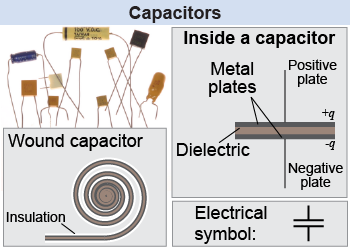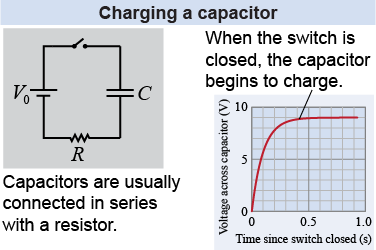|
 Capacitors are found in many circuits and electronics devices. A capacitor is a device for storing electric charge and hence electrical energy. Inside the capacitor are two parallel metal plates separated by a material called the dielectric. To make capacitors that store more charge, they are often wound into a spiral along with an insulating layer. The electrical symbol for a capacitor consists of two parallel lines that represent the parallel metal plates inside the device.
Capacitors are found in many circuits and electronics devices. A capacitor is a device for storing electric charge and hence electrical energy. Inside the capacitor are two parallel metal plates separated by a material called the dielectric. To make capacitors that store more charge, they are often wound into a spiral along with an insulating layer. The electrical symbol for a capacitor consists of two parallel lines that represent the parallel metal plates inside the device. 
|
 A capacitor is uncharged until it is connected to a voltage or potential difference across its two metal plates. In circuits, a capacitor is usually connected in series with a resistor and battery. When the circuit is completed (or the switch closed), the capacitor begins to charge. As positive charge accumulates on one plate, an equal amount of negative charge accumulates on the other plate. The difference in charge creates a potential difference or voltage between the two plates.
A capacitor is uncharged until it is connected to a voltage or potential difference across its two metal plates. In circuits, a capacitor is usually connected in series with a resistor and battery. When the circuit is completed (or the switch closed), the capacitor begins to charge. As positive charge accumulates on one plate, an equal amount of negative charge accumulates on the other plate. The difference in charge creates a potential difference or voltage between the two plates. 
|
The charging time for most capacitors in circuits is very short—milliseconds or less! Once fully charged, the charge on each of its plates is given by equation (18.7). 
|
| (18.7) | | | q | = | electric charge (C) | | C | = | capacitance (C/V) | | V | = | electric potential (V) |
| Charge stored in a
capacitor
|
|
The new quantity in equation (18.7) is the capacitance, which is a measure of how effectively the capacitor can store charge. The units of capacitance are the farad (F), named after Michael Faraday. Just as one coulomb is a very large amount of charge, one farad is also a very large capacitance. Typical values for capacitance range from a picofarad (1 pF = 10−12 F) to a microfarad (1 μF = 10−6 F). Since q = CV, capacitance can also be expressed as coulombs per volt (C/V). 
|
Since one plate of a capacitor stores positive charge while the other stores negative charge, a capacitor can also be considered as a store of electrical potential energy. The stored electrical energy in a capacitor is given by equation (18.8). As a larger voltage is applied across a capacitor, the stored energy increases—as V2! 
|
| (18.8) | | | Ep | = | stored energy (J) | | C | = | capacitance (F) | | V | = | voltage or potential difference (V) |
| Energy stored
in a capacitor
|
|

